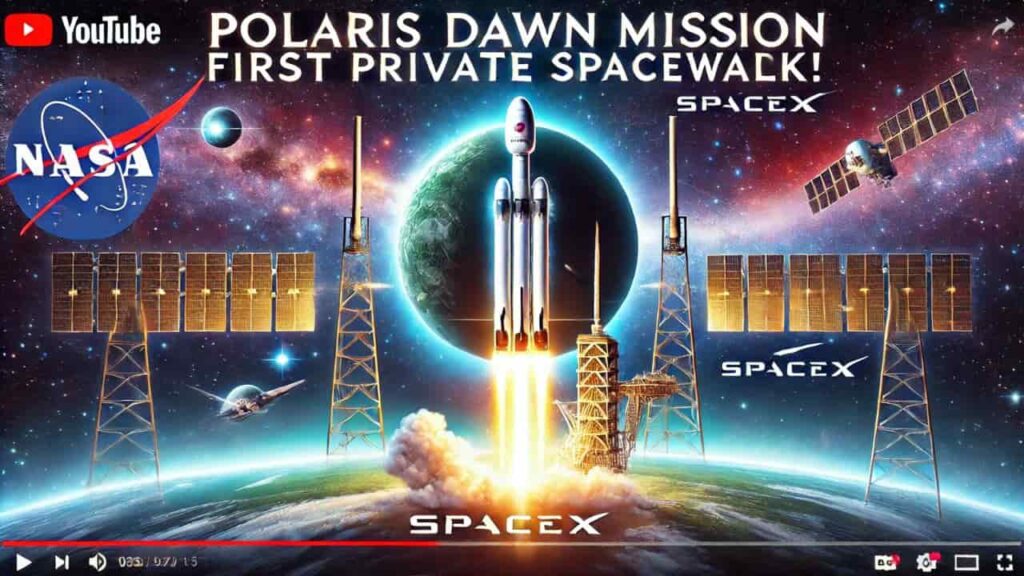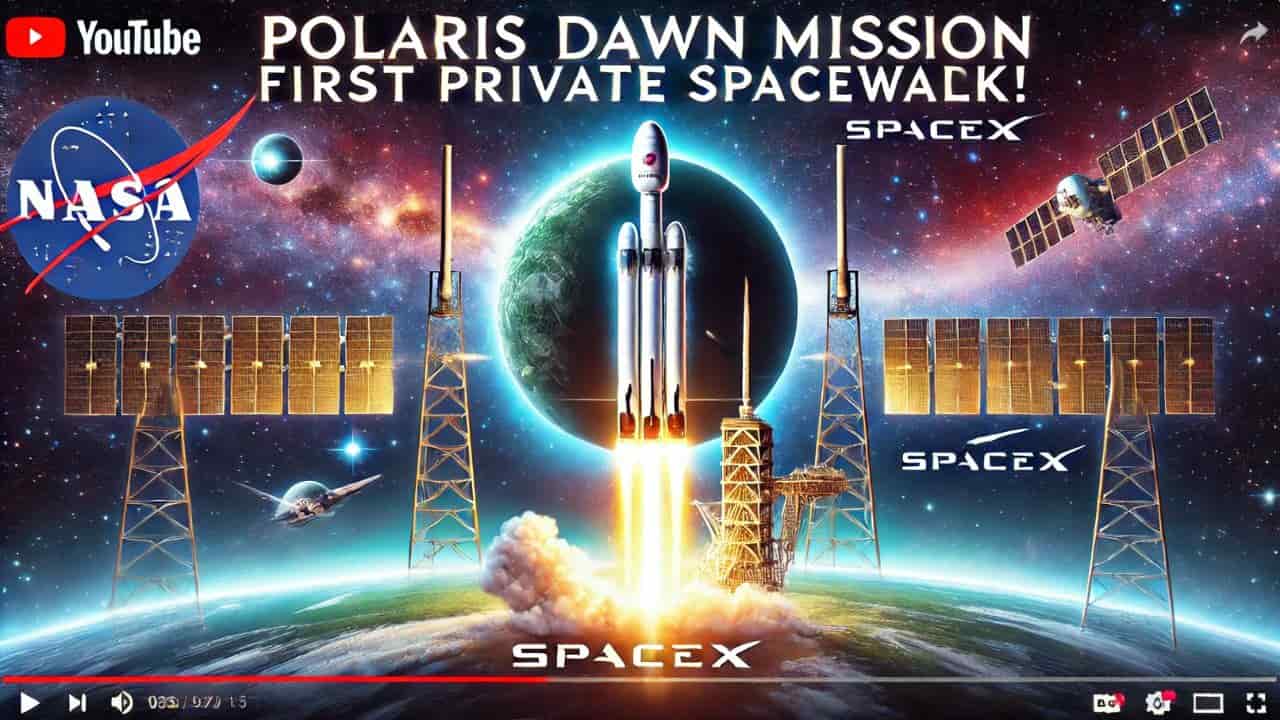SpaceX, Polaris Dawn mission, private spacewalk, Falcon 9 launch, Crew Dragon spacecraft, highest Earth orbit, private space travel, SpaceX September 2024, SpaceX civilian astronauts, space exploration, Jared Isaacman
SpaceX has announced a new target date for the Polaris Dawn mission, aiming to launch on September 10, 2024. This groundbreaking mission includes the first private spacewalk and will send civilian astronauts to the highest Earth orbit since the Apollo program.

SpaceX Announces New Target Date for Polaris Dawn Mission
SpaceX, the leading private space exploration company founded by Elon Musk, has set a new date for the much-anticipated Polaris Dawn mission. The launch, which has seen multiple delays over the past few weeks due to various factors, is now scheduled for Tuesday, September 10, 2024, weather permitting. The mission, an ambitious project aimed at advancing human space exploration, will see four civilian astronauts aboard the Crew Dragon spacecraft reaching the highest Earth orbit since NASA’s Apollo program.
This groundbreaking mission is expected to contribute significantly to private space travel, marking several firsts in the industry, including a private spacewalk. As excitement builds around the launch, here’s a deep dive into the significance of the Polaris Dawn mission, its objectives, and what it means for the future of space travel.
Delays and New Launch Date
Initially planned for earlier in the year, the Polaris Dawn mission faced multiple postponements due to unfavorable weather conditions and technical checks. The company’s latest announcement has confirmed that the launch will now take place on Tuesday, September 10, at 3:38 a.m. from Launch Complex 39A at NASA’s Kennedy Space Center in Florida. The Falcon 9 rocket, SpaceX’s reliable workhorse, will carry the Crew Dragon spacecraft, along with the four civilian astronauts who have been rigorously training for this historic mission.
The delays, although frustrating for some, highlight the challenges of space missions, particularly private ones, where the safety of the crew and precision of the launch are of utmost importance. While space enthusiasts eagerly await liftoff, SpaceX is closely monitoring weather conditions, as officials have stated that the current forecast offers only a 40% chance of favorable weather. Additionally, splashdown sites for the Dragon’s return to Earth are also under watch.
The Polaris Dawn Mission: Pushing the Boundaries of Space Travel
The Polaris Dawn mission stands out for several reasons, one of which is the mission’s goal to send astronauts to the highest Earth orbit since the iconic Apollo lunar missions. This alone underscores the magnitude of the endeavor, as the crew will venture into a region of space that hasn’t been visited by astronauts in decades. The mission represents a key milestone in SpaceX’s overarching goal of making space travel more accessible and eventually enabling human exploration of Mars.
A particularly exciting aspect of Polaris Dawn is that it will be the first time a private space company attempts to conduct a spacewalk, known as an extravehicular activity (EVA). Historically, spacewalks have been conducted by astronauts aboard government-led missions, such as NASA or Roscosmos. This spacewalk will provide invaluable data and experience for future private missions, helping engineers and scientists to develop better technology and protocols for conducting operations in the vacuum of space.
The Crew: Pioneers of Private Space Exploration
Onboard the Crew Dragon spacecraft will be a team of four highly trained civilians, each of whom brings unique expertise and backgrounds to the mission. The mission commander, Jared Isaacman, a billionaire entrepreneur and pilot, leads the team. Isaacman, who also funded the Polaris Dawn mission, is no stranger to space travel, having participated in the Inspiration4 mission, another private space venture by SpaceX, in 2021.
Isaacman will be joined by three other astronauts: Scott Poteet, a retired U.S. Air Force lieutenant colonel and experienced pilot; Sarah Gillis, a SpaceX engineer responsible for training the astronauts for the mission; and Anna Menon, a SpaceX lead operations engineer who will be part of the medical team during the mission. Together, the crew embodies the growing democratization of space travel, showcasing how civilians with diverse skill sets can contribute to space exploration.
Objectives of the Polaris Dawn Mission
The mission’s key objective is to achieve the highest Earth orbit since the Apollo missions, surpassing the altitude typically reached by the International Space Station (ISS), which orbits around 250 miles above Earth. Polaris Dawn aims to reach an altitude of 870 miles, placing the crew in a much higher orbit. This altitude will allow the team to conduct various experiments, including space-to-ground communication testing using Starlink, SpaceX’s satellite internet service.
In addition to these experiments, the crew will also participate in the first private spacewalk. The spacewalk will be a crucial step in advancing the capabilities of private space missions, as it will provide real-time data on the challenges and risks involved in working outside a spacecraft in a vacuum environment. SpaceX hopes this will pave the way for future missions, including those that might involve longer-duration spacewalks or more complex operations, such as building infrastructure in space.
Another significant goal of the mission is to gather data on the effects of high-altitude space travel on the human body. Since the crew will be flying higher than the ISS, they will be exposed to different radiation levels and space weather phenomena. The data collected will be critical in informing future missions, particularly those aimed at exploring deep space or traveling to Mars, where astronauts will face even harsher conditions.
Importance of Private Space Missions
Polaris Dawn is part of a broader trend toward increasing private sector involvement in space exploration. Once the exclusive domain of government agencies like NASA, space exploration is now being driven by companies such as SpaceX, Blue Origin, and Virgin Galactic. These companies are not only lowering the cost of access to space but also pushing technological boundaries in ways that were previously unimaginable.
SpaceX, in particular, has been at the forefront of this movement. Its reusable rocket technology has revolutionized the space industry, making it possible to launch more missions at a fraction of the cost of traditional space programs. By making space travel more accessible, SpaceX is opening the door for more scientific research, commercial ventures, and even tourism in space.
The Polaris Dawn mission, with its ambitious goals and focus on pushing the limits of private space travel, exemplifies this new era of exploration. It serves as a reminder that space is no longer the exclusive domain of government agencies, and that the private sector has a crucial role to play in humanity’s future among the stars.
The Future of Space Exploration
As we look ahead to the future, it’s clear that missions like Polaris Dawn will be pivotal in shaping the trajectory of space exploration. The mission’s success could set the stage for more complex and ambitious private space ventures, including missions to the Moon, Mars, and beyond. Moreover, the data and experience gained from this mission will be invaluable in developing the next generation of spacecraft, spacesuits, and space-based technologies.
Elon Musk’s vision of making life multi-planetary is ambitious, but with each successful mission, SpaceX inches closer to turning that vision into reality. The Polaris Dawn mission represents another critical step toward that future, showcasing the potential of private space travel and inspiring the next generation of explorers.
As the space industry continues to evolve, collaborations between private companies and government space agencies will likely become more common. These partnerships can help accelerate the development of new technologies, reduce the costs of space missions, and ultimately make space more accessible to people from all walks of life.
Conclusion
The Polaris Dawn mission is not just another space launch—it’s a historic moment in the ongoing evolution of private space exploration. With its ambitious objectives, including the highest Earth orbit since Apollo and the first private spacewalk, the mission is set to break new ground and provide critical insights for future missions. The crew of four civilian astronauts, led by Jared Isaacman, symbolizes the growing role of private individuals in space exploration.
As SpaceX prepares for the September 10 launch, the world watches with anticipation. The success of this mission will mark a significant milestone in space exploration, opening new doors for scientific research, commercial space ventures, and eventually, the colonization of other planets. With each step forward, we come closer to realizing humanity’s dreams of exploring the cosmos.
Read More
- NASA and Sierra Space Dream Chaser Arrives in Florida for Launch Prep
- NASA Citizen Scientists Discover Hypervelocity Star Zooming Out of the Milky Way
- NASA Invites Media to Northrop Grumman 21st Station Resupply Launch
- NASA Missy Elliott: Hip-Hop Song Beamed to Venus










